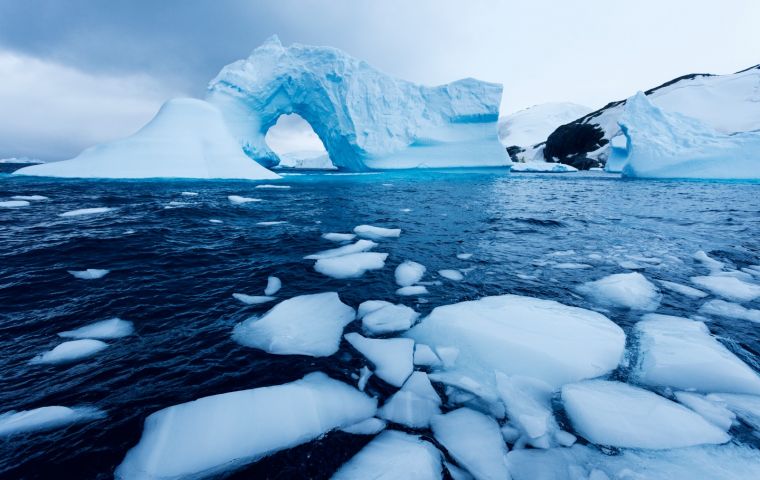MercoPress. South Atlantic News Agency
BAS report, the Antarctic glaciers ice loss is “unprecedented”
 Scientists collecting shells from beach on one of the Lindsey Islands, Pine Island Bay. US R/V Nathaniel B Palmer is in the background. Photo: James Kirkham
Scientists collecting shells from beach on one of the Lindsey Islands, Pine Island Bay. US R/V Nathaniel B Palmer is in the background. Photo: James Kirkham Two crucial glaciers in West Antarctica may be losing ice faster than they have over the last 5,000 years, according to a new study published in June. The international team, led by the University of Maine and including British Antarctic Survey (BAS) geologist Dr Joanne Johnson, examined the history of Thwaites and Pine Island Glaciers in the West Antarctic Ice Sheet.
These glaciers extend deep into the heart of the ice sheet, are currently melting extremely rapidly and have the potential to contribute up to 3.4 meters to global sea level rise in the coming centuries.
To understand how relative sea level has changed over the past few thousand years in this critical region, the team collected shells from several ancient beaches that are now elevated above modern sea level and used radiocarbon dating of the shells to discover when the beaches formed. This information is used to determine whether there have been any large-scale changes in glacier size during the time period covered by the beaches. BAS scientists and geomatics specialists helped to sample the shells and played an important role in determining precise altitudes for the beaches.
The shells were collected from extremely remote islands in Pine Island Bay. These islands have seldom been visited, and can only be accessed by small boats or helicopters from a ship. The scientists had only a few hours on each of the islands, but with assistance from US and UK colleagues, they managed to collect more than 50 shells and penguin bones for the study. The sample collection was organized and conducted by lead author, PhD student Scott Braddock from University of Maine, USA, and supported by the US research ship R/V Nathaniel B Palmer.
The scientists found that relative sea level in the region fell steadily over the last 5,000 years. This suggests that glaciers were relatively stable during that time, with no evidence for large-scale retreat or advance. Changes in size caused by retreat or advance of glaciers affects “crustal loading”, a term that describes the amount of depression the earth’s surface experiences when a mass of ice is sitting on it.
Brenda Hall, corresponding author of the study and professor at the School of Earth and Climate Sciences and the Climate Change Institute (in US) says: “Relative sea-level change allows you to see large-scale crustal loading and unloading by ice. For example, glacier re-advance, which would result in crustal loading, would slow the rate of relative sea-level fall or potentially even cause submergence of the land below sea level.”
The team also found that the rate of relative sea level fall recorded by the shells was almost five times lower than today. The most likely reason for such a large difference is recent rapid ice loss in the region.
BAS geologist Dr Joanne Johnson, lead UK principal investigator of the Geological History Constraints (GHC) team, part of the International Thwaites Glacier Collaboration that conducted the research, says: “Looking back in time allows us to understand how these massive glaciers react to changes in climate. Our results show that even when climate was warmer 5,000 years ago, the glaciers were not substantially smaller than they are today. However, the much slower rate of relative sea level fall we measured implies that the dramatic ice loss we are now seeing is unprecedented in the recent geological past. We urgently need to understand more about these glaciers to determine whether their current retreat could be reversed, and under what conditions that could happen. This is crucial if we are to plan effectively for future sea level rise.”
Relative sea-level data preclude major late Holocene ice-mass change in Pine Island Bay by Braddock, S., Hall, B., Johnson, J., Balco, G., Spoth, M., Whitehouse, P., Campbell, S., Goehring, B., Rood, D., and Woodward, J., is published in the journal Nature Geoscience.




Top Comments
Disclaimer & comment rulesCommenting for this story is now closed.
If you have a Facebook account, become a fan and comment on our Facebook Page!